Navigating Complexity Three Critical Challenges Reshaping Media Planning.

Photo by Tom Fink
Introduction.
Media planning, choosing where and when to show ads to the right people, has fundamentally shifted; the days of relying on a few TV spots or blanket newspaper campaigns are over. In my experience, even at the local level with small retail clients, Facebook was once a dependable way to reach audiences - but now, people have tuned out, engaging instead in smaller, more fragmented ways across multiple platforms. Success now demands more than technical expertise; it requires agility, forward-thinking, and a strong ethical compass. Planners must balance strategy, ethics, and creativity as audiences grow increasingly scattered, demanding, and privacy-conscious.
In this post, I’ll tackle three big questions shaping the future of media planning:
First, what practical barriers make reaching people so tough for advertisers? From fragmented audiences to the fight for attention and muddled measurement, I’ll explain why the old playbook no longer works.
Second, what do we do about privacy, when people’s words and actions rarely match? I’ll explore the privacy paradox and the ethical dilemmas it creates across borders.
Third, how do we handle artificial intelligence, a tool promising ease but risking complexity in creativity and trust?
These strategic questions will decide which brands thrive and which fade away.

Photo by Travis Saylor
What are the biggest barriers to successful media planning from an advertiser’s perspective?
The old-school model - find a big audience, blast out a single message, job done, is finished. Advertisers now face a tangled mess: fragmented audiences, a constant battle for attention, inconsistent measurement, and the ever-growing influence (and complexity) of AI.
First, let’s talk about fragmentation.
UK audiences no longer gather in one place, they’ve scattered into distinct digital worlds, each with its own culture and habits. Almost everyone’s online (97.8%), and nearly 80% are active on social media. YouTube casts the widest net, but younger audiences flock to TikTok and Instagram, while traditional TV still holds the attention of older viewers (DataReportal 2025; We Are Social 2025; Statista 2025). This fragmentation means brands must speak many languages, not just one.

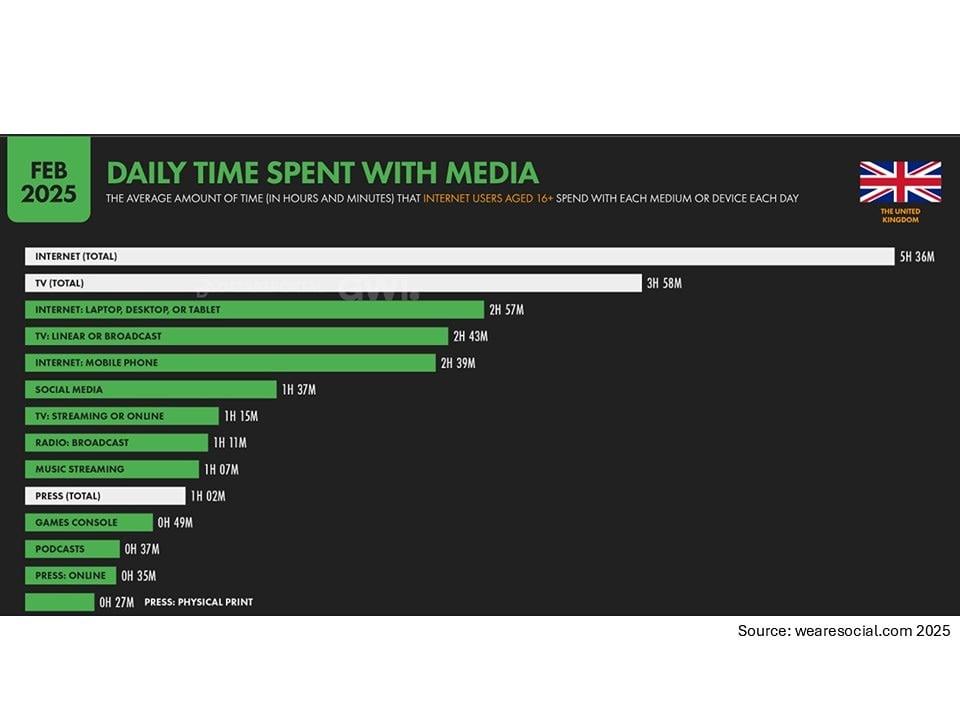
We Are Social’s 2025 data (Figures 1 and 2) show just how fragmented UK media use has become, with audiences splitting their time across a range of formats and platforms (We Are Social 2025). When I think about my own habits I realise they reflect this unpredictability. In this landscape, audiences rarely overlap, making one-size-fits-all campaigns obsolete, planners must now tailor content to each platform’s style while keeping the brand’s identity clear.
Fragmentation is just the start; there’s also the attention problem.
Getting your ad in front of someone is easy; getting them to notice it is another matter. Programmatic ads mean impressions are cheap, but does anyone really pay attention? Karen Nelson-Field’s research (2025) says we should focus on “attention availability” which measures how much real attention your ad gets compared to what was possible. The calculation is shown in Figure 3:

Attention availability is shaped as much by the media environment as by individual viewer choice. Factors like scroll speed and ad placement play a critical role (Nelson-Field 2025). Personally, I notice that on Instagram, there’s only a fleeting second to capture my interest before I scroll past, whereas on Netflix, the viewing context is more relaxed and offers a slightly longer window to engage me. This shift toward micro-moments means that making the most of brief opportunities is far more important than aiming to hold attention for extended periods. And in my work on communication campaigns, I’ve seen that the old belief, repeating a message everywhere guarantees impact no longer holds true. Industry leaders echo this, with brands increasingly prioritising high-impact, context-specific placements over blanket repetition, recognising that attention is now a scarce and fragmented resource (VCCP Media and Nelson-Field 2025).
Then comes measurement, the next challenge.
Every platform counts views, clicks, or likes differently, and these numbers aren’t ‘apples-to-apples’. A Twitter impression isn’t the same as a YouTube view or TikTok engagement and treating them as if they are just muddies the waters. Platforms have a vested interest in showing you the rosiest numbers, which only adds to the confusion.
The IAB UK’s “Measurement Manifesto” advocates for standardisation across media channels, but this often results in flattening out the very differences that matter most for advertisers (Miles 2024). For a concise overview of these challenges and the rationale behind the Manifesto, take a look at this short video (IAB UK 2024).
Until the industry develops a more nuanced approach, planners are left to cobble together their own hybrid measurement systems, blending platform-specific metrics with broader goals like brand awareness and long-term loyalty.
And then there’s artificial intelligence.
AI is often hailed as the answer to fragmentation, promising to find patterns and automate optimisation. But it’s not a magic wand. Sometimes, AI makes fragmentation worse by creating ever-narrower audience segments based on old data, risking missed trends or reinforcing biases (The Economist 2025). As AI gets better at grabbing attention, planners face tough questions about privacy and manipulation. The challenge is to use AI for insight and efficiency, without letting it take over the creative or ethical steering wheel.
So, if the practical barriers are already this complex, what happens when we add the thorny issue of privacy into the mix?

Photo by Tima Miroshnichenko
The paradox of privacy - if no one is watching, do ethical concerns and personal privacy really matter to global media planning?
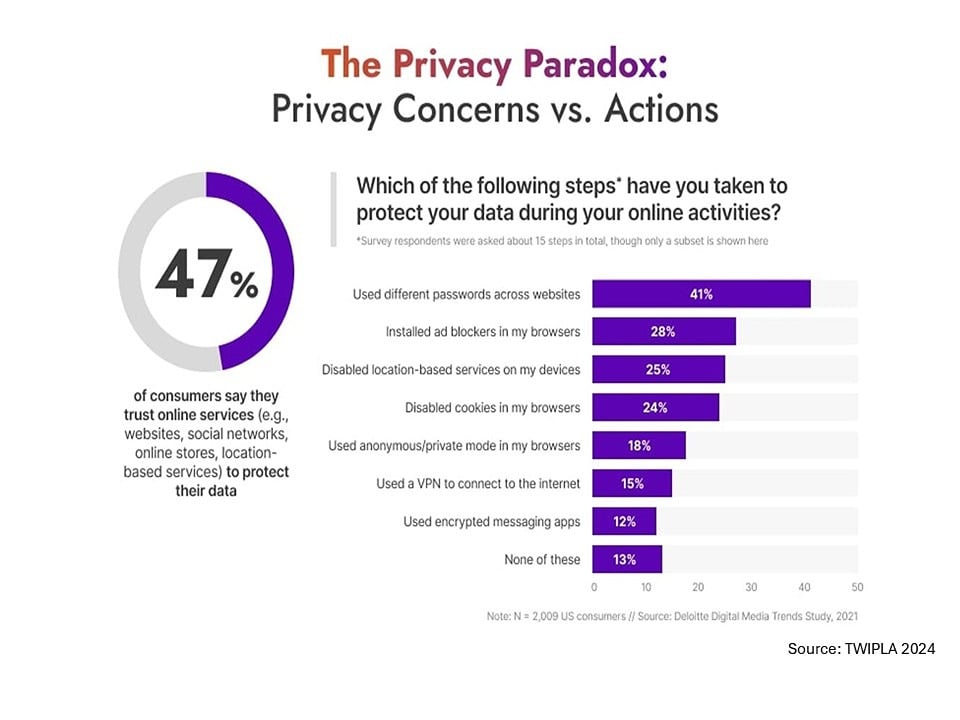
Privacy is one of those issues everyone says they care about, but the reality is far messier. People often claim to worry about their data, but when it comes down to it, they’ll trade privacy for convenience, personalisation, or a shiny new app. This “privacy paradox” is both an opportunity and a minefield for media planners, illustrated in Figure 4.
It’s not just about what people say versus what they do. Platforms like TikTok have made data collection almost invisible, weaving it into the user experience so smoothly that most barely notice (TWIPLA 2024). The result? Users get the instant rewards they crave, while behind the scenes, their behaviour is being turned into hyper-targeted ads, often without them realising just how much they’re giving away.
Shoshana Zuboff’s idea of “surveillance capitalism” really brings this home.
Today’s digital giants have turned our everyday actions into a commodity, selling insights about our lives to the highest bidder (Zuboff 2019). I love it when Spotify recommends the perfect song or Netflix lines up my next binge, but I realise there’s a cost: the slow erosion of consent, autonomy, and trust.
Media planners have to ask: just because we can collect and use this data, should we? Is the short-term gain of hitting the right target worth the long-term risk of losing trust, or running afoul of the law?
The global patchwork of privacy regulations adds another layer of complexity.
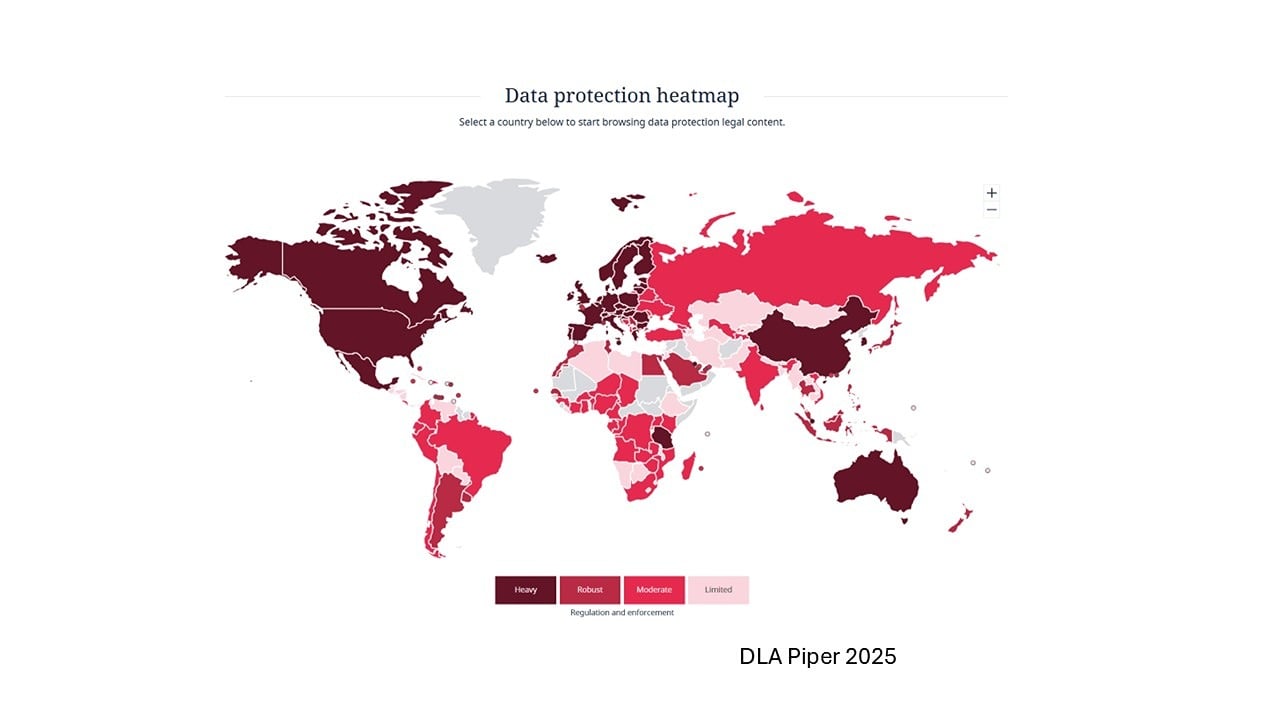
The EU’s GDPR is strict and clear about consent, while the US relies on a patchwork of state laws like California’s CCPA. India and other countries are rolling out their own rules too, DLA Piper produced a heatmap showing the global picture, shown in Figure 5 (2025). On top of the legal implications, what feels respectful in one country might seem intrusive in another, there’s no universal playbook (EMB Global 2024).
So why does privacy matter, even if nobody’s watching?
Firstly, trust is fragile. The Facebook-Cambridge Analytica scandal showed how quickly a brand’s reputation can unravel when data is mishandled (Criddle 2020). Once trust is lost, it’s a long, expensive road to win it back.
And regulations are only getting tougher, with enforcement ramping up. Brands that take privacy seriously now will be better prepared for whatever comes next. And in today’s hyper-connected world, a single privacy slip can go viral, damaging a brand overnight.
Perhaps most importantly, brands that genuinely respect privacy stand out in a crowded, sceptical market. Increasingly, consumers are choosing companies that show they care about data protection.
What’s the way forward?
Privacy can’t be an afterthought or a box-ticking exercise. It needs to be baked into every campaign from the start:
Collect only what you need, be upfront about why you’re collecting it, and make sure consent is real, not just a ticked box (TWIPLA 2024).
Use plain language, not legalese, and adapt your approach to fit local laws and cultural expectations (Ambekar 2023).
And don’t forget regular check-ups: ethical audits are key to keeping up with changing standards.
Handled well, privacy isn’t a barrier, it’s a strategic asset. Brands that get it right will build stronger, more loyal relationships and be ready for whatever the future throws at them.
So - if privacy is the minefield beneath every campaign, artificial intelligence is the new force reshaping how we even approach planning.

Photo Elkady 2023
In an AI driven world, what are the challenges for media planners?
I’ve already touched on AI, but it’s such a massive subject that it deserves its own spotlight. AI is the hot topic, promising to make everything faster, smarter, and more efficient. The sheer number of tools, covering everything from predictive analytics to programmatic buying and content creation, is staggering. But with all that promise comes a fresh set of headaches: too many tools, the risk of losing the human touch, and a boatload of ethical questions.
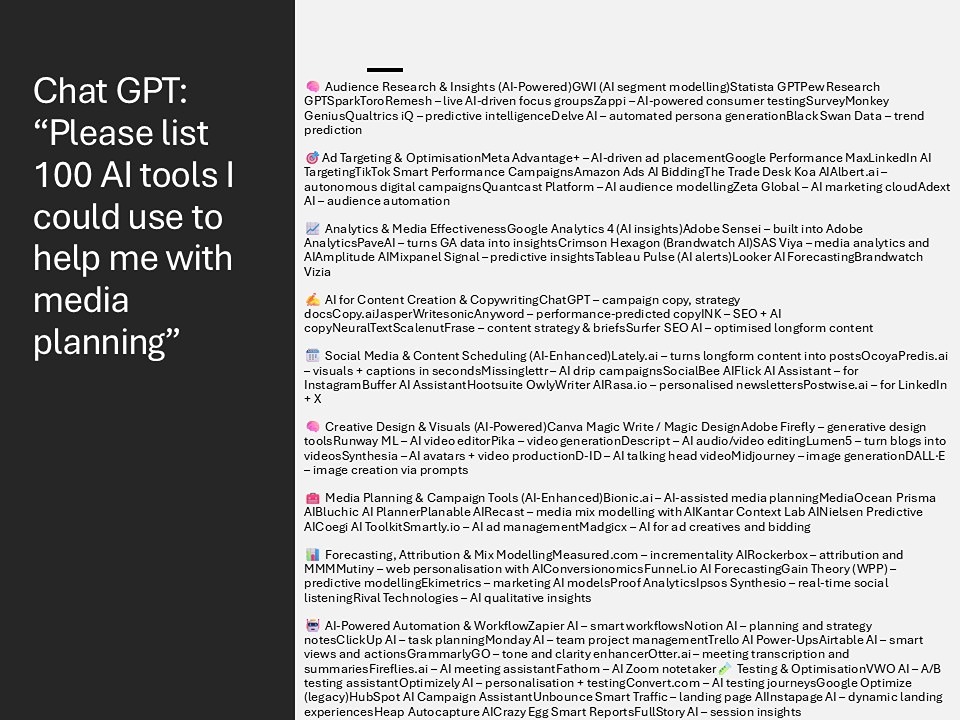
Dazzling possibilities.
AI can quickly analyse data, spot patterns, and automate tasks that once took hours. When I asked ChatGPT to list 100 AI tools for media planning (see Figure 6), it was just a glimpse, there are likely thousands. Yet, this abundance could complicate planning, creating silos and confusion instead of making things easier.
The IAB’s State of Data 2025 report found that 70% of agencies, brands, and publishers still haven’t fully integrated AI into their planning, buying, and analysis. Nearly two-thirds say they’re grappling with issues like data quality, security, and fragmented tech (IAB 2025). The advice? Pick your tools wisely, make sure they work together, and invest in training and clear governance to keep things running smoothly.
And what about creativity?
AI is brilliant at the nuts and bolts, audience segmentation, bid optimisation, personalisation, but it’s not so great at storytelling or understanding cultural nuance. AI’s creativity is, as researchers put it, “bounded”. It can remix what’s already out there, but it can’t come up with something truly original or emotionally rich (Ismayilzada et al 2024). The danger is ending up with campaigns that are technically perfect but emotionally flat.
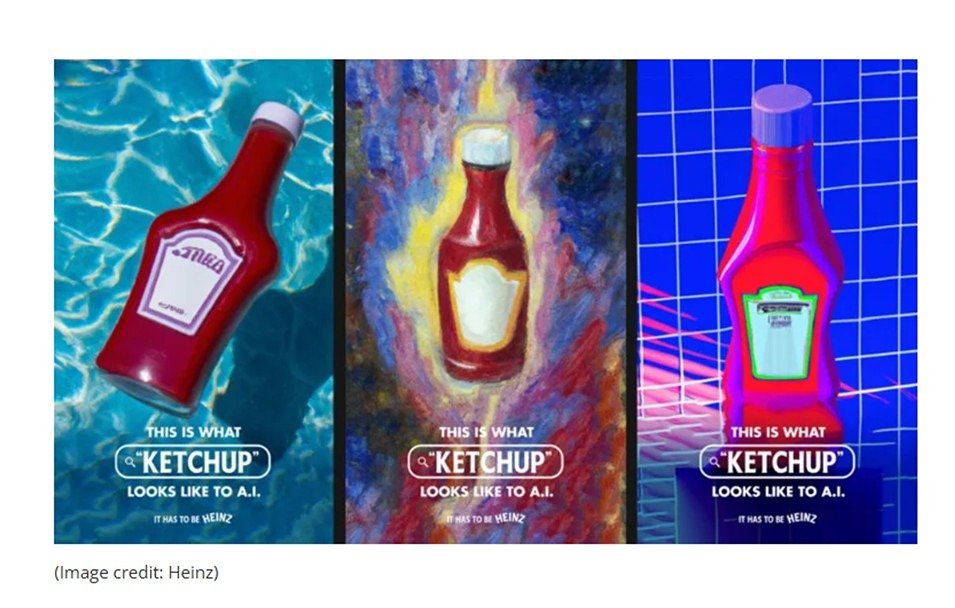
A great example of how humans and AI can work together is the Heinz “AI Ketchup” campaign, shown in Figure 7. The AI generated all sorts of ketchup images, but it was the human team who spotted the real insight: that Heinz is so iconic, even AI thinks of it first (Coggan 2022; Young Urban Project 2025). The campaign worked because people brought cultural understanding and emotional intelligence to the table, things AI just can’t replicate.
That’s why it’s so important to build in “creative checkpoints”, moments where people can question, interpret, and add meaning to what the algorithms suggest (Ismayilzada et al 2024).
AI isn’t just a creative challenge; it’s an ethical one too.
AI relies on historical data, which can bake in biases and exclude certain groups. If you’re not careful, you can end up running campaigns that unintentionally reinforce stereotypes or leave people out. And because AI decision-making is often a black box, it’s hard to know exactly how choices are being made, especially risky for global campaigns where cultural context is everything.
The IAB’s report flags these ethical and bias issues as major concerns, right alongside data security and legal compliance (2025). Planners have a duty to challenge AI outputs, keep campaigns inclusive, and demand transparency from their tools (Ring Publishing 2024). As privacy laws evolve, staying on top of compliance is only going to get more important.
Setting up checks and balances, like ethics boards, fairness audits, and mandatory human review, can help keep things on track. Without them, brands risk losing trust and running into legal trouble (creating more work), which defeats the whole purpose of using AI in the first place.

Photo by Pixabay
Conclusion.
Embrace the complexity and turn challenges into opportunities.
The challenges facing media planners today, fragmentation, privacy, and AI, aren’t just technical hurdles. They’re reshaping the foundations of the industry, and the brands that succeed will be those that let go of outdated ideas about unified audiences and universal messages, and instead embrace the messiness and opportunity of the new landscape.
Complexity isn’t the enemy; it’s a chance to build deeper, more meaningful connections.
Privacy, handled well, can set a brand apart and build lasting trust.
And as for AI, its limitations only make the human touch more valuable.
Planners who embrace these realities, crafting platform-specific strategies, putting ethics front and centre, and finding the right balance between automation and creativity, will be the ones who shape the future.
The brands that thrive will be those that stop fighting complexity and start using it to their advantage, turning today’s challenges into tomorrow’s edge.

Photo: cottonbro
References & Bibliography
Ambekar, M. (2023) The Ethics of Data Privacy in Digital Marketing. LinkedIn. Available at: https://www.linkedin.com/pulse/ethics-data-privacy-digital-marketing-mandar-ambekar (Accessed: 26 June 2025).
Coggan, G. (2022) ‘Heinz asked AI to “draw ketchup” (and it went remarkably well)’, Creative Bloq, 2 August. Available at: https://www.creativebloq.com/news/heinz-ai-draw-ketchup (Accessed: 30 June 2025).
Criddle, C. (2020) 'Facebook sued over Cambridge Analytica data scandal', BBC News, 28 October. Available at: https://www.bbc.co.uk/news/technology-54722362 (Accessed: 27 June 2025).
DataReportal (2025) Digital 2025: The United Kingdom. Available at: https://datareportal.com/reports/digital-2025-united-kingdom (Accessed: 2 July 2025).
DLA Piper (2025) Data Protection Laws of the World. Available at: https://www.dlapiperdataprotection.com/ (Accessed: 27 June 2025).
Elkady, A. (2023) Why AI is 'drastically improving' the effectiveness of media planning. The Media Leader, 10 May. Available at: https://uk.themedialeader.com/why-ai-is-drastically-improving-the-effectiveness-of-media-planning/ (Accessed: 25 June 2025).
EMB Global (2024) Digital Advertising Challenges: Ethical Dilemmas. Available at: https://blog.emb.global/digital-advertising-challenges-ethical-dilemmas/ (Accessed: 27 June 2025).
IAB (2025) State of Data 2025: Evolution of AI for Media Campaigns. Available at: https://www.iab.com/wp-content/uploads/2025/03/IAB_State_of_Data_2025_March__V2.pdf (Accessed: 1 July 2025).
Ismayilzada, M., Paul, D., Bosselut, A. and van der Plas, L. (2024) ‘Creativity in AI: Progresses and Challenges’, arXiv preprint arXiv:2410.17218. Available at: https://arxiv.org/abs/2410.17218 (Accessed: 28 June 2025).
Miles, L. (2024) On Device Manifesto: Embrace media fragmentation. IAB UK, 27 June. Available at: https://www.iabuk.com/member-content/device-manifesto-embrace-media-fragmentation (Accessed: 25 June 2025).
Nelson-Field, K. (2025) The Missing 'Availability'. WARC Opinion, 20 May. Available at: https://www.warc.com/newsandopinion/opinion/the-missing-availability/en-gb/7050 (Accessed: 25 June 2025).
OpenAI ChatGPT (2025) ChatGPT response to Rachel Roberts prompt: “Please list 100 AI tools I could use to help me with media planning” 2 July 2025 Available at: https://chat.openai.com/chat (Accessed: 2 July 2025)
Ring Publishing (2024) ‘The Ethical & Legal Challenges of AI in Media’, Ring Publishing. Available at: https://ringpublishing.com/blog/ai-tools-and-insights/the-ethical-and-legal-challenges-of-ai-in-media/4g2vh4b (Accessed: 1 July 2025).
The Economist (2025) AI is turning the ad business upside down. 18 June. Available at: https://www.economist.com/business/2025/06/18/ai-is-turning-the-ad-business-upside-down (Accessed: 25 June 2025).
TWIPLA (2024) The Privacy Paradox: Torn Between Love and Fear. Available at: https://www.twipla.com/en/blog/the-privacy-paradox (Accessed: 25 June 2025).
VCCP Media and Nelson-Field, K. (2025) Hacking the Attention Economy: VCCP Media and Dr Karen Nelson-Field reveal 1.5 second formula for effective digital advertising. Available at: https://www.vccp.com/uk/news/2025/may/hacking-the-attention-economy-vccp-media-and-dr-karen-nelson-field-reveal-1-5-second-formula-for-effective-digital-advertising (Accessed: 1 July 2025).
We Are Social (2025) Digital 2025 United Kingdom. Available at: https://wearesocial.com/uk/blog/2025/02/digital-2025-the-essential-guide-to-the-global-state-of-digital/ (Accessed: 2 July 2025).
Young Urban Project (2025) ‘6 Best AI Marketing Case Studies’, Young Urban Project, 28 May. Available at: https://www.youngurbanproject.com/ai-marketing-case-studies/ (Accessed: 28 June 2025).
Zuboff, S. (2019) The Age of Surveillance Capitalism. London: Profile Books.
Bibliography
Abdullahi, A. (2024) 'Meta to Fully Automate Ad Creation in 'Redefinition' of Industry', eWEEK, 3 June. Available at: https://www.eweek.com/news/meta-ads-ai-automation/ (Accessed: 30 June 2025).
Barnett, M. (2012) ‘Google’s Street View scandal is an all-round mess’, Marketing Week, 31 July. Available at: https://www.marketingweek.com/googles-street-view-scandal-is-an-all-round-mess/ (Accessed: 20 June 2025).
Bray Leino Insights Team (n.d.) ‘Beyond GDPR: a guide to major data privacy regulation outside the EU’, WARC. Available at: https://www.warc.com/content/article/bestprac/beyond‑gdpr‑a‑guide‑to‑major‑data‑privacy‑regulation‑outside‑the‑eu/127344 (Accessed: 30 June 2025).
Bray Leino Insights Team (n.d.) ‘What we know about data protection and privacy’, WARC. Available at: https://www.warc.com/content/article/bestprac/what-we-know-about-data-protection-and-privacy/111995 (Accessed: 30 June 2025).
Chaffey, D. and Ellis-Chadwick, F. (2022) Digital Marketing: Strategy, Implementation and Practice. 8th edn. Harlow, UK: Pearson.
Clayton, E. (2020) ‘The give and take with walled gardens’, WARC, 8 October. Available at: https://www.warc.com/.../the-give-and-take-with-walled-gardens/en-gb/3856 (Accessed: 3 June 2025).
IAB Europe (2020) Attitudes to Programmatic Advertising Report 2020. IAB Europe: Brussels, 1 October. Available at: https://iabeurope.eu/wp-content/uploads/2020/10/IAB-Europe-Attitudes-to-Programmatic-Advertising-Report-2020-1.pdf (Accessed: 27 June 2025).
Reglitz, M. (2020) ‘The human right to free Internet access’, Journal of Applied Philosophy, 37(2), pp. 314–331. doi: 10.1111/japp.12395 (Early online: 11 Nov 2019) (Accessed: 27 June 2025).
Shields, R. (2023) ‘Marketers seek adaptability amid a fragmented post‑cookie landscape’, Digiday, 1 March. Available at: https://digiday.com/marketing/marketers-seek-adaptability-amid-a-fragmented-post-cookie-landscape/ (Accessed: 3 June 2025).
Snigel (n.d.) ‘10 Best Alternatives To Third Party Cookies’, Snigel Blog. Available at: https://snigel.com/blog/best-third-party-cookie-alternatives (Accessed: 30 June 2025).
Statista (2024) Share of UK teens using YouTube as their main platform. Available at: https://www.statista.com/ (Accessed: 1 July 2025).
Stringer, P. (2024) ‘Challenges for media planning in an AI-driven world’, WARC. Available at: https://campaignbriefasia.com/2025/01/17/warc-releases-the-future-of-media-2025-defined-by-abundance-driven-by-algorithms/ (Accessed: 28 June 2025).
Figures
Figure 1 Media Use in the UK (wearesocial 2025).
Figure 2 Daily Time Spent With Media (wearesocial 2025).
Figure 3: Calculating Attention Availability (Nelson-Field 2025).
Figure 4: The Privacy Paradox (TWIPLA 2024).
Figure 5: DLA's Data Protection Heat map (DLA Piper 2025).
Figure 6: Chat GPT – Please list 100 AI tools I could use to help me with media planning (2025).
Comments